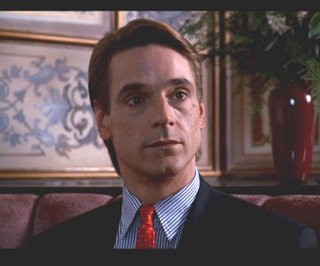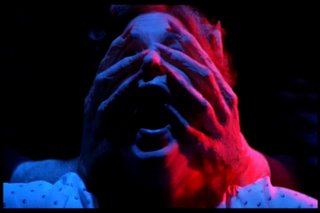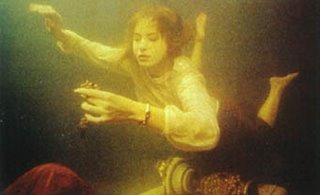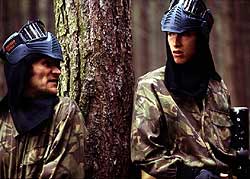more adventures in filmmaking, again, part two (ii)
Whenever you're writing a screenplay you will recieve notes from readers for changes you should make. It's a lot of hard work reading scripts - I'm doing it at the moment for a low budget feature scheme in bog town...
it would be good to have something multi purpose to say... you always expect that the reader has them at hand anyway.
Here's a series of script notes I recently sent out to the great Tony Grisoni, I hadn't had time to read his new script and anyway - he hadn't actually sent it to me...
Start with something funny happening to somebody, or something bad, or something or just something happening to someone.
Page 1 – 400, Sc 1 – 500. Maybe remove all explanations of characters motives throughout, replace dramatic reasons with random action – random is very popular with a younger demographic.
Page 56 – WHAT???!!!
Page 1 – 400, all Scenes. Repetition is also important to a lot of 1 - 3 year olds. Maybe make allowances for very young viewers by having the story told again and again.
Page 16 Sc 97– not clear what is happening to whom and why it has happened to him!
Page 90
look I know he’s the antagonist and the bad guy, but is it really necessary to paint him in such a bad light! No one’s that bad, surely? Maybe make him nicer throughout from the beginning, maybe make him do a few nice things, be kind to people and such.
Page 78 Sc 230 – need a clear idea of why who wants what and when.
Page 134 Sc 300 – cut out all dialogue relating to the characters apologising to each other.
Needs speeding up at the beginning, get going slower though and spend some more time speeding through things make the pace a lot more erratic and even.
Have all characters repeat every single line they say for clarity. I know it’ll make it longer but it’ll appear to be weightier. And it will be heavier to carry as well.
Always have your characters wear the same clothes, whatever the weather or time of day it’s easier in the edit to change it around. At present I imagine they change too often into dinner jackets and the like, especially around page 30 for a formal dinner with an important character suddenly arriving to announce some very grave news.
It’s important in all character descriptions to be aware of each persons shoe size.
It’s good but the audience could do with being taken out of the story occasionally, below are a couple of examples:
If it’s a Romantic Comedy:
A moment when a man, unconnected to the story, possibly just passing by and enjoying himself, is suddenly distracted by our romatic couple finally kissing he smiles warmly although he is initially out of focus we pull focus onto him and follow him home, where, still smiling he administers a lethal injection to his long serving family pet (a parrot!) ill from eating the wrong kind of cuttle fish. He breaks down and sits at the kitchen table for a few moments until the phone rings with important news of an avian illness breakthrough – we cut back to our leads...
An Action/Adventure story:
Mid way through your contemporary, high-octane thrills and spills, the hero takes time out to reflect on the antics of his grandfather, himself a decorated war hero cut to: WWII - High on a cliff face our heroes ascend – paying homage to Guns of Navarone – until a major comes across a small nest of rare eggs! A speech about the value of these eggs on the then legal trade to collectors follows, giving the audience a chance to put the film into historical context. A private slips and falls, silently, so as not to alert the enemy to his comrades position, to his death on the rocks below. Cut back to our contemporary hero as he makes breakfast for his hot girlfriend, a soon to be dead undercover officer in the NYPD. Oh the irony!
Make it more complex, please ...
the audience must be made to feel that people are saying something significant even when nothing is happening have more dialogue and ignore my earlier note about repeating each line twice instead, for a Mamet styled complex web of a drama, here is a guide to writing dialogue about nothing two men are looking out of a window while they wait for the scene to get started finally, one feels more important than the other:
MAMET STYLED DIALOGUE-
Man One
Did you see that? Did you? Did you see that?
Man Two
Did I see that? Did you see that? Did I see that?
Man One
Did you? Did you? Did you see it?
Man Two
It?
Man One
That!
Man Two
“Did you see that?”
Man One
Did I see that?
Man Two
Did you? Did you see that? Is that what you’re saying? Did I see that? Did I?
Man One
We
Man Two
Well – Did I?
Man One
What?
Man two
“What?”
Man One
Er
Man Two
What? What did I see? Did I see it or that or what?
Man Three
Hey you guys, guys, guys did you by any chance see the thing I just saw? Did you see that? Did you see the thing?
There isn’t a scene in a police cell! But why? Here’s an idea...
Scene In Police Cell:
Any film about crime needs one, or even a comedy, romantic drama or anything else maybe you have characters or individuals already ahving to contemplate things in an overnight cell maybe before court appearance or while police go about your investigations well if you do –
- A young man in the background, part of a cast of nere-do-wells, skulks nakedly in a corner and grinds his shoes into the rough ground of the cell, stubbing a rolled cigarette.. there’s a knock at the door and a young officer hands him his freshly washed, pressed and ironed clothes, the prisoner hands him a tip.







